Audit Report on the New York City Human Resources Administration’s Provision of Language Access Services
AUDIT IMPACT
Summary of Findings
The audit found that the New York City Human Resources Administration (HRA) generally complied with the translation standards prescribed by relevant laws, standards, and guidelines. HRA provides language access services to non-English Language Preference (NELP) clients as required, with one exception related to the translation feature on the ACCESS HRA website. The audit also determined, through site observations and client surveys conducted at HRA’s 26 Benefits Access Centers/SNAP Centers/Medicaid Offices, that HRA’s language access services generally meet the needs of the NELP population as intended, and NELP clients generally have the same access to apply for government services as the agency’s English-speaking population.
The audit assessed HRA’s compliance with relevant laws, standards, and guidelines to ensure residents with NELP have adequate and effective access to City services, assessed whether the NELP population was fairly served by HRA, and included a participatory element to assess the effectiveness from the standpoint of end users. The audit identified one area where HRA could improve access to City services on its ACCESS HRA website.
INTRODUCTION
Background
New York City, with a population of more than 8 million people, is home to one of the most diverse populations in the world, with more than 3 million foreign-born residents from more than 200 countries. According to the New York City Department of City Planning, nearly one-half of all New Yorkers speak a language other than English at home, and almost 25% of City residents aged five and over are not proficient in English. For residents with a non-English Language Preference (NELP), interacting with City government and receiving access to City services can be a challenge.[1]
Since 2003, the City government has worked to enhance language access for NELP residents through a series of legislative actions, including:
- Local Law 73 of 2003: LL73 requires that HRA, the Department of Homeless Services (DHS), the Administration for Children’s Services (ACS), and the Department of Health and Mental Hygiene (DOHMH) provide free language assistance services to NELP clients. The law applies to agency services, as well as job Centers and food stamp offices.
- Executive Order No.120 (2008): EO 120, New York’s “Citywide Policy on Language Access to Ensure Effective Delivery of City Services,” requires all City agencies engaged in direct customer services to provide language access.
- Local Law 25 of 2016: LL25 requires all City websites to include a translation feature for the most widely spoken languages in the City other than English.
- Local Law 30 of 2017: LL30 requires all City agencies that provide direct public or emergency services to designate a Language Access Coordinator and to develop Language Access Plans (LAP).[2] LAPs consist of the following components: identification and translation of the most commonly distributed public documents; interpretive services, including telephonic interpretation in at least 100 languages; training of frontline workers on language access policies; posting of signage in conspicuous locations about the availability of free interpretation services; and the establishment of an appropriate monitoring and measurement system regarding the provision of agency language services. LL30 requires agencies to update their LAPs every three years. Agencies are also expected to incorporate consideration of language access in public communications (including emergency notifications, public hearings, and events), and craft widely distributed documents using plain language principles.
HRA is the largest local social services agency in the country.[3] It helps more than 3 million New Yorkers annually and provides economic support and social services to families and individuals through the administration of major benefit programs including Cash Assistance and Supplemental Nutritional Assistance Program (SNAP) benefits. HRA operates various Benefits Access Centers across the five boroughs where dedicated case managers and staff work closely with New Yorkers in need to connect them to HRA’s comprehensive network of benefits and social services, including financial assistance (Cash Assistance), one-time assistance with emergencies (Emergency Assistance), food assistance (SNAP), and eviction prevention or housing assistance.[4] According to HRA, approximately 30% of its clients identify as NELP.
Objectives
The objectives of this audit were to determine whether: (1) HRA is providing agency services to the NELP population in the languages required by relevant laws, standards, and guidelines; (2) the agency’s language access services meet the needs of the NELP population as intended; and (3) the NELP population has the same access to apply for government services offered by HRA as the English-speaking population to ensure equity and inclusion.
Discussion of Audit Results with HRA
The matters covered in this report were discussed with HRA officials during and at the conclusion of this audit. An Exit Conference Summary was sent to HRA on February 23, 2023, and discussed with HRA officials at an exit conference held on March 1, 2023. On March 10, 2023, we submitted a Draft Report to HRA with a request for written comments. We received a written response from HRA on March 23, 2023. In its response, HRA generally agreed with the report’s findings and recommendation, stating: “We sincerely appreciate the efforts that your office has devoted in this audit to assist us in achieving our goals.”
The full text of HRA’s response is included as an addendum to this report.
DETAILED FINDINGS
The audit found that HRA generally complied with the translation standards prescribed by relevant laws, standards, and guidelines, and that its language access services generally met the needs of the NELP population as intended, with one exception related to the translation feature on the ACCESS HRA website. The audit also determined, through site observations and client surveys conducted at HRA’s 26 Benefits Access Centers/SNAP Centers/Medicaid Offices, that HRA’s NELP clients generally had the same access to apply for government services as the agency’s English-speaking population. In addition, the majority of the 100 NELP clients surveyed during the audit expressed satisfaction with language access services provided.
HRA Provides Language Access Services to NELP Clients as Required
The auditors found that HRA:
- Developed and maintains a Language Access Plan and designated a Language Access Coordinator in accordance with LL30 requirements. The audit found that HRA’s Language Access Plan was updated at least once every three years as required, and that its current plan and the name/title of the Language Access Coordinator is available on its website.
- Provides access to pertinent information on its main website in over 100 languages. The auditors found that the translation feature allows users to view the website in over 100 languages other than English, including the top 10 designated NYC NELP languages.
- Notifies the public of the right to free interpretation services. The auditors observed that HRA informs the public of the availability of free language services through posters in its locations, notices on service tickets, and notices in application and renewal packets sent to clients. See Appendix I, Pictures #2, #3, and #4 for example illustrations of various HRA notifications of the availability of free interpretation services.
- Translates its most commonly distributed client and public‐facing documents into the top 10 designated NYC NELP languages. For application forms for Federal and/or State programs (SNAP, TANF etc.) that may not be available in all 10 NYC NELP languages, HRA uses telephonic interpretation services to assist NELP clients with these forms so the clients can still apply for program benefits. The auditors observed that multilingual documents including pamphlets, brochures, and application forms are available at the Centers. Additionally, staff have access to HRA eDocs to print documents in the top 10 NYC NELP languages if necessary. See Appendix I, Picture #7 for an example illustration of multilingual documents at HRA locations.
- Trains frontline and outreach staff, as well as the managers and supervisors, on providing language access to NELP clients annually and trains incoming staff during the onboarding process. HRA’s language access training centers on the diverse communities served by the agency and provides an overview of Federal, State, and local laws governing the provision of services to NELP clients. It also includes “tough situation” scenarios and reminds employees of the importance of accurately recording a client’s preferred language.Auditors reviewed training materials and attendance sheets and found that staff were trained on NELP procedures including how and when to access telephonic interpretation services and/or employ in‐person interpretation services, sign language interpretation services, and written translations, and how to contact its Office of Refugee and Immigrant Affairs (ORIA) in the event staff have further questions or client communication challenges and require support. In addition, the auditors observed staff using the telephonic interpretation services.
- Provides language access services to NELP clients. HRA contracts with several language access vendors for language access services including Language Line for telephonic interpretation and written translation, Geneva Worldwide, Inc. for on‐site interpretation (excluding sign language), and Accurate Communication, Inc. for on‐site interpretation and sign language interpretation (video and in‐person). In addition, the auditors found that bilingual staff and contracted language access vendors are able to provide on-site interpretation and document translation in the top 10 designated NELP languages as well as provide phone interpretation services in more than 200 languages, including the top 10 designated NELP languages as required by LL30.
- Responds to and addresses language access complaints in a timely manner. Auditors reviewed language access complaint data for the period 2018 through 2021. The data showed 221 language access complaints which were marked resolved. The auditors also observed in the Centers that in-person and telephonic language access complaints are addressed immediately by HRA staff.In addition, the public can submit language access complaints, questions, or requests by calling 311 or HRA’s Infoline, speaking to a Director at any HRA location, emailing ORIA, or using the Contact Us section of HRA’s website. If a complaint is solely limited to language services concerns, ORIA will work with the program involved to ensure that all staff are reminded of their language access duties and address any systematic language access concerns. Complaints that include a language component are forwarded to ORIA and the specific program area for resolution.
- Uses various measures to ensure its NELP population has the same access to apply for government services as the English-speaking population. HRA’s Benefits Access Centers have self-service express check-in kiosk machines that generate service tickets which include the notification of the right to free interpretation services, in multiple languages. Service tickets also indicate clients’ language preferences and alert staff that language access services are necessary. HRA also provides self-service scanners for electronic document scanning and submitting documents to HRA. Auditors observed that the main screen on the kiosk and printer/scanner allows users to select language preferences from options that include English and the 10 NELP languages specified in LL30.[5]
See Appendix I, Pictures #1 and #8 for example illustrations of the main screen of HRA’s self-service kiosk and self-service scanner, respectively. See Appendix I, Picture #2 for an example illustration of HRA service tickets with the multilingual notification of the right to free interpretation services and the client’s language preference.
During observations of HRA’s Centers, auditors found that staff were professional, courteous, and familiar with the process of providing language access services, which included finding available bilingual staff members or immediately contacting HRA’s contracted telephonic interpretation provider for translation services via a dual handset telephone that allows all participants to be on the call simultaneously. Staff were also equipped with HRA’s language access materials including Language Cards, I Speak Cards, instructions for working with telephonic interpreters, and the Notice of Free Interpretation Services which also includes an I Speak Card at the bottom.
See Appendix I, Picture #5 for an example illustration of HRA’s Language Card for NELP clients. See Appendix I, Picture #6 for an example illustration of HRA language access materials (Language Card, I Speak Card) and dual-handset telephone at staff desks.
HRA’s ACCESS HRA Website Has a Limited Translation Feature
The ACCESS HRA website allows clients to apply for SNAP, re-certify for their SNAP and Cash Assistance benefits, submit a Periodic Report for SNAP, edit case details (i.e., mailing address, phone number, and email address), upload documents, view notices, and more. However, the audit found that the website’s default translation feature is based upon LL73 requirements rather than the updated LL30 and is only available in 6 of the top 10 designated NYC NELP languages (Spanish, Chinese, Russian, Haitian Créole, Korean, and Arabic). It is not available in Bengali, Urdu, French, or Polish. Users of select web browsers such as Microsoft Edge or Google may have access to these languages, but only if the Google translation widget happens to automatically appear when Spanish, Chinese, Russian, or Arabic is selected on the top menu.
When this issue was brought to HRA’s attention, officials responded that HRA is exploring expansion into additional languages as noted in its current Language Access Plan. In its written response, HRA further stated that “[u]pdating the professional translations to include Bengali, Urdu, French and Polish is a complicated and expensive project, which will also take time to establish funding and a corresponding timeline. However, HRA will take this recommendation under advisement and continue to explore expansion into additional languages as noted in our current Language Access Plan. [It] will update the default translation feature on the ACCESS HRA website to include Bengali, Urdu, French, and Polish in accordance with Local Law 30.” According to HRA’s updated Corrective Action Plan, the targeted date for completion is tentatively set for June 2024.
The auditors acknowledge the concerns related to updating and funding the translation feature and encourage HRA to shorten its tentative 13-month completion timeline to the extent possible. It is important to ensure that NELP populations have equitable access to HRA benefits and resources as soon as possible.
HRA Client Satisfaction Survey Results
To ensure that NELP clients have the same access to apply for services as English-speaking clients, the auditors conducted a series of site observations and administered client surveys. The survey was designed to determine whether clients were satisfied with their interactions with HRA, focusing only on individuals in need of NELP services. Survey responses were obtained on-site at HRA’s 26 Benefits Access Centers/SNAP Centers/Medicaid Offices.
The auditors attempted to survey 300 clients and were ultimately successful in receiving survey responses from 100 NELP clients that used or attempted to use HRA services at the 26 Benefits Access Centers. Eighty-eight percent of those surveyed indicated that agency staff treated them with courtesy and respect, and 100% said that HRA adequately provided language interpretation services. Overwhelmingly, respondents said that HRA staff were informative, communicative, and able to assist with basic services.
Not all respondents completed responses to all the survey questions related to the use of HRA facilities, but where responses were received, they were similarly positive.[6] Most respondents rated the ease of use of HRA facilities (including PC banks at SNAP Centers, ACCESS HRA accounts, and document scanning machines) “average” to “excellent.” See Appendix II for a comprehensive breakdown of survey results. See below for a breakdown of survey categories and responses.
| Category | Percentage rated “Yes” |
| Treated with courtesy and respect by agency staff? | 88% |
| Automated reminder and/or call back received in preferred language? | 65% |
| Category | Percentage rated “Average” or higher |
| Ease of use when first accessing/using HRA services (HRA PC Bank at SNAP Center) | 29% (The remaining 71% either did not respond or the question was not applicable) |
| Ease of use when first accessing/using HRA services (ACCESS HRA) | 80% |
| Ease of use when first accessing/using HRA services (Kiosk Self Service Area) | 60% |
| Ease of use when first accessing/using HRA services (Kiosk Self Service Check-In) | 72% |
| Ease of use when first accessing/using HRA services (Self Service Scanning) | 26% (The remaining 74% either did not respond or the question was not applicable) |
| Staff’s ability to communicate specific information in preferred language (Information related to client’s next steps) | 85% |
| Staff’s ability to communicate specific information in preferred language (Information on how to make a change (i.e., address/telephone/language) | 90% |
| Staff’s ability to communicate specific information in preferred language (Information on how to return documents) | 75% |
| Staff’s ability to communicate specific information in preferred language (Provision of language interpretation services) | 100% |
| Staff’s ability to communicate specific information in preferred language (Responses to client’s questions) | 80% |
| Staff’s ability to communicate specific information in preferred language (General communication with staff) | 75% |
RECOMMENDATION
To address the abovementioned finding, the auditors propose that HRA:
- Update the default translation feature on its ACCESS HRA website to include Bengali, Urdu, French, and Polish to ensure the top 10 designated NYC NELP languages are available.HRA Response: The agency agreed with this recommendation.
Recommendation Follow-up
Follow-up will be conducted periodically to determine the implementation status of each recommendation contained in this report. Status updates are reported in the Audit Recommendations Tracker available here: https://comptroller.nyc.gov/services/for-the-public/audit/audit-recommendations-tracker/
SCOPE AND METHODOLOGY
We conducted this performance audit in accordance with generally accepted government auditing standards. Those standards require that we plan and perform the audit to obtain sufficient, appropriate evidence to provide a reasonable basis for our findings and conclusions based on our audit objectives. We believe that the evidence obtained provides a reasonable basis for our findings and conclusions based on our audit objective. This audit was conducted in accordance with the audit responsibilities of the City Comptroller as set forth in Chapter 5, §93, of the New York City Charter.
The scope of this audit was January 1, 2018 through January 27, 2023.
To achieve the audit objectives, auditors performed the following:
- Reviewed Local Law 73 of 2003, EO 120 of 2008, Local Law 25 of 2016, and Local Law 30 of 2017.
- Created compliance checklists to assess HRA’s compliance with Local Law 30.
- Conducted interviews and walkthroughs with key HRA personnel involved with the provision of language access services.
- Reviewed and assessed whether HRA’s language assistance plan was developed in accordance with Local Law 30, using the required four-factor analysis.
- Tested whether HRA provided direct public services in at least the top 10 NELP languages spoken by the New York City population by (1) reviewing HRA’s Language Access Plan; (2) conducting visits at locations; and (3) conducting interviews with pertinent personnel regarding the provision of language access services.
- Obtained and reviewed documentation and assessed whether HRA identified and translated the agency’s most commonly distributed public documents provided to or completed by the public.
- Tested whether interpretation services, including the use of telephonic interpretation services, are available. Auditors made anonymous phone calls to HRA’s main public access lines (311 and its direct Infoline) to determine whether it could provide telephonic interpreter services in the top 10 NELP languages. When the call to Infoline was answered, the main menu recording prompted the auditors to choose the language to be used. For the top 10 NYC NELP languages, the appropriate LEP operator responded. For additional languages, the call was transferred to an English-speaking operator to determine the language of choice, who then transferred the call to an additional translating service.
- Conducted site visits at all HRA locations throughout the five boroughs where direct public services are available to observe HRA’s translation services and ensure equity and inclusion for HRA’s NELP clients. To accomplish this, auditors (1) checked for the required signage and multilingual documents; (2) interviewed pertinent personnel regarding the provision of language access services and inquiries with frontline HRA staff (including Directors) on the process of providing language access; and (3) observed demonstrations of staff contacting telephonic interpreters. Auditors also determined whether the agency’s language access materials for staff and the public were readily available and observed the additional measures used to assist NELP clients such as the language availability on kiosk machines and scanners.[7]
- Obtained and reviewed the employee manual for language access training and written policies and procedures.
- Reviewed HRA signage kits to determine whether they contained multilingual posters.
- Reviewed and assessed whether HRA established an appropriate monitoring and measurement system regarding the provision of agency language services. HRA’s Paperless Office System requires staff to input the language preference on the Communications Preferences Screen which keeps track of the preferred languages of all clients including written and spoken.
- Reviewed and assessed whether HRA created appropriate public awareness strategies for the agency’s serviced NELP population by visiting HRA’s locations to determine whether the required notification of the right of free interpretation services is posted in conspicuous locations. Auditors observed various HRA documents notifying the public of the right to free interpretation such as the posters on the wall, Language Cards and I Speak cards.
- Reviewed whether HRA’s Language Access Plan and name and title of the designated Language Access Coordinator were posted to its website.
- Accessed HRA’s website and translated the information into the top 10 languages spoken in New York City.
- Conducted Client Survey Questionnaire at the 26 Benefits Access Centers/SNAP Centers/Medicaid Offices that were visited throughout the City to understand clients’ perspectives on the HRA intake process. Survey topics included whether clients were able to get services in their preferred NELP language, professionalism of HRA staff, applying for benefits, and HRA’s responsiveness to client needs. The questionnaire was designed to determine whether clients were satisfied with their interactions with HRA, focusing only on individuals in need of NELP services. The auditors attempted to survey 300 HRA clients at HRA locations and identified 100 NELP clients that used or attempted to use HRA services. To accomplish this, the auditors waited until the clients completed their interactions with HRA staff or the self-service kiosks, self-service scanners and the computers within the PC Bank, and inquired if they would like to complete a brief survey. This took place within the facility or outside the facility after they left the premises.
- Reviewed statistics on HRA language access complaints between 2018 and 2021.
APPENDIX I
HRA LANGUAGE ACCESS COMPLIANCE OBSERVATIONS
#1: HRA SELF-SERVICE EXPRESS CHECK-IN KIOSK
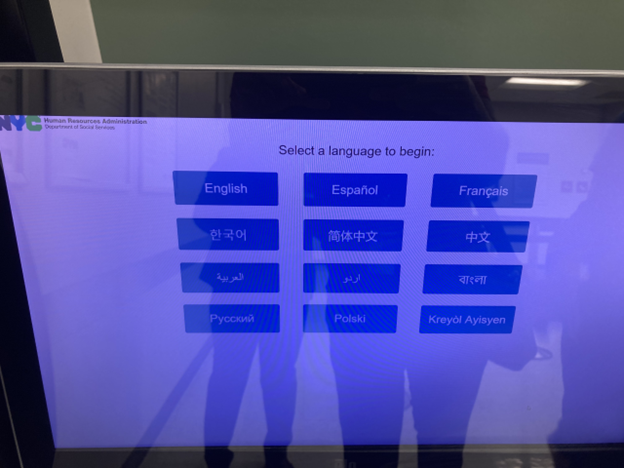
The kiosk’s main screen allows the client to select a language from the top 10 NYC NELP languages.
#2: SERVICE TICKET
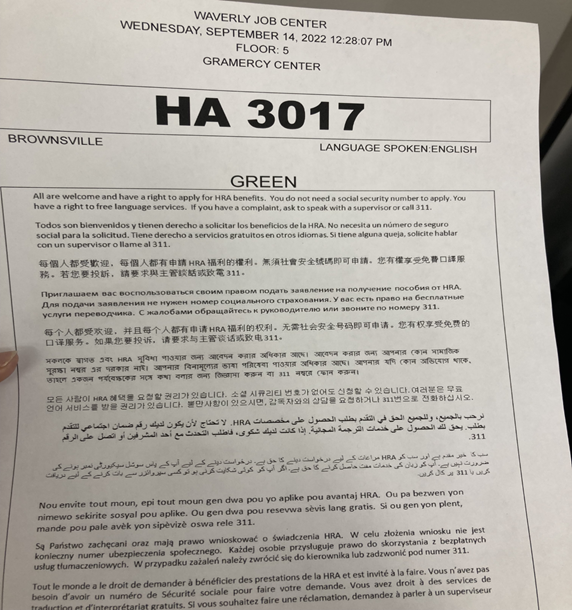
HRA’s self-service kiosk prints service tickets that include the client’s ticket number and language preference, the required notification of the right to free interpretation services, and the location where the client should go for services.
#3: HRA SIGNAGE

Signage is conspicuously placed and notifies the public of the availability of and their right to free interpretation services in HRA locations.
#4: CLIENT WAITING AREA

The video screen displays multilingual information about HRA including the required notification of the right to free interpretation services.
#5: HRA LANGUAGE CARD
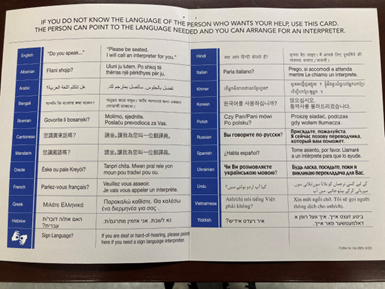
HRA’s Language Card helps staff communicate with clients.
#6: DESKS EQUIPPED WITH LANGUAGE ACCESS MATERIALS & DUAL HANDSET TELEPHONES
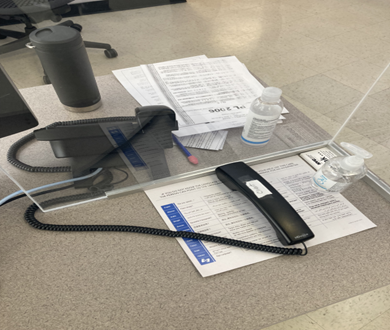
HRA language access materials (i.e., Language Card and the I Speak Card) are used to help staff identify a client’s language. Dual handset telephones are used for contacting telephonic interpretation services.
#7: HRA DOCUMENTS AVAILABLE IN MULTIPLE LANGUAGES
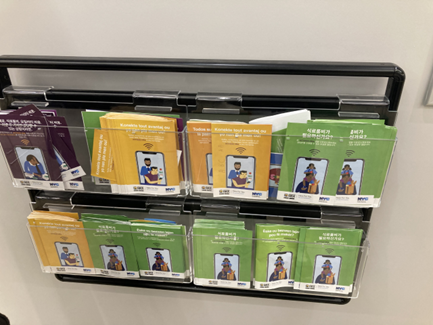
#8: HRA SELF-SERVICE SCANNER
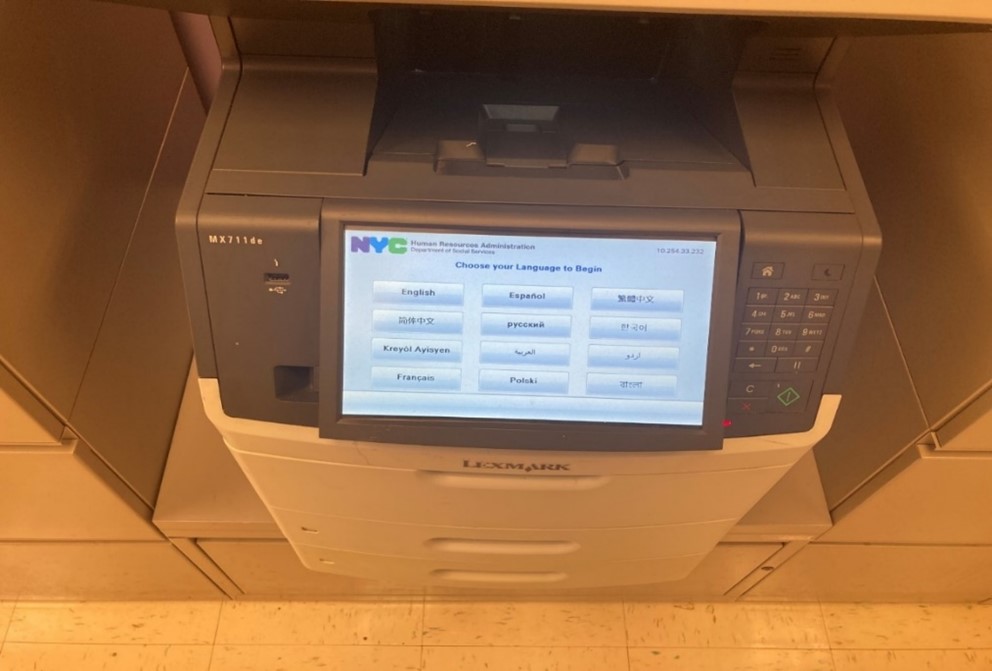
The main screen allows the client to select a language from the top 10 NYC NELP languages to scan and submit documents to HRA.
APPENDIX II
The following is a breakdown of NELP client survey questions/topics and results:
Treated with courtesy and respect by agency staff?
| Yes | 88 | 88% |
| No | 4 | 4% |
| No Response | 8 | 8% |
| Total | 100 | 100% |
Ease of use when first accessing/using HRA services
| HRA PC Bank at SNAP Center | |||
| Poor | 0 | 0% | |
| Average | 6 | 6% | |
| Very Good | 20 | 20% | |
| Excellent | 3 | 3% | |
| No Response | 40 | 40% | |
| N/A | 31 | 31% | |
| Total | 100 | 100% | |
| ACCESS HRA | ||
| Poor | 0 | 0% |
| Average | 25 | 25% |
| Very Good | 30 | 30% |
| Excellent | 25 | 25% |
| No Response | 4 | 4% |
| N/A | 16 | 16% |
| Total | 100 | 100% |
| Kiosk Self-Service Area | ||
| Poor | 0 | 0% |
| Average | 40 | 40% |
| Very Good | 15 | 15% |
| Excellent | 5 | 5% |
| No Response | 13 | 13% |
| N/A | 27 | 27% |
| Total | 100 | 100% |
| Kiosk Self-Service Check-In | ||
| Poor | 0 | 0% |
| Average | 37 | 37% |
| Very Good | 20 | 20% |
| Excellent | 15 | 15% |
| No Response | 28 | 28% |
| N/A | 0 | 0% |
| Total | 100 | 100% |
| Self-Service Scanning | ||
| Poor | 0 | 0% |
| Average | 20 | 20% |
| Very Good | 6 | 6% |
| Excellent | 0 | 0% |
| No Response | 24 | 24% |
| N/A | 50 | 50% |
| Total | 100 | 100% |
Automated reminder and/or call back received in preferred language
| Yes | 65 | 65% |
| No | 10 | 10% |
| No Response | 10 | 10% |
| N/A | 15 | 15% |
| Total | 100 | 100% |
Staff’s ability to communicate specific information in preferred language
| Information related to client’s next steps | ||
|---|---|---|
| Poor | 0 | 0% |
| Average | 60 | 60% |
| Very Good | 20 | 20% |
| Excellent | 5 | 5% |
| No Response | 10 | 10% |
| N/A | 5 | 5% |
| Total | 100 | 100% |
| Information on how to make a change (i.e., address/telephone/language) | ||
| Poor | 1 | 1% |
| Average | 70 | 70% |
| Very Good | 10 | 10% |
| Excellent | 10 | 10% |
| No Response | 3 | 3% |
| N/A | 6 | 6% |
| Total | 100 | 100% |
| Information on how to return documents | ||
|---|---|---|
| Poor | 0 | 0% |
| Average | 30 | 30% |
| Very Good | 25 | 25% |
| Excellent | 20 | 20% |
| No Response | 15 | 15% |
| N/A | 10 | 10% |
| Total | 100 | 100% |
| Provision of language interpretation services | ||
| Poor | 0 | 0% |
| Average | 47 | 47% |
| Very Good | 38 | 38% |
| Excellent | 15 | 15% |
| No Response | 0 | 0% |
| N/A | 0 | 0% |
| Total | 100 | 100% |
| Responses to client’s questions | ||
| Poor | 0 | 0% |
| Average | 45 | 45% |
| Very Good | 20 | 20% |
| Excellent | 15 | 15% |
| No Response | 5 | 5% |
| N/A | 15 | 15% |
| Total | 100 | 100% |
| General communication with staff | ||
| Poor | 0 | 0% |
| Average | 60 | 60% |
| Very Good | 10 | 10% |
| Excellent | 5 | 5% |
| No Response | 25 | 25% |
| N/A | 0 | 0% |
| Total | 100 | 100% |
Endnotes
[1] Local Law 73 of 2003, Executive Order 120 of 2008, and Local Law 30 of 2017 use the term “limited English proficient” or “LEP”; however, for the purposes of this report, the term “non-English language preference” (or “NELP”) will be used.
[2] LAPs were developed using a four-factor analysis based on guidance issued by the U.S. Department of Justice. These factors included: the number or proportion of NELP persons in the eligible service population; the frequency with which NELP individuals come into contact with the agency; the importance of the benefit, service, information, or encounter to the NELP person; and the resources available to the agency and the costs of providing various types of language services.
[3] In 2017, HRA integrated with DHS under the management structure of the Department of Social Services (DSS). Accordingly, DSS oversees both HRA and DHS, and is comprised of the administrative units of both agencies. According to DSS, through integrated management for HRA and DHS, client services can be provided to New York City residents more seamlessly and effectively. As a result of the merger, DSS/HRA’s 2021 Language Access Plan also applies to DHS, and the Language Access Coordinator is the same for both agencies.
[4] Benefits Access Centers were formerly known as Job Centers. The Centers were renamed in August 2022 to better reflect the services and supports offered at these sites and help clearly communicate the function of these sites to reach even more New Yorkers in need. HRA’s Family Independence Administration operates HRA’s Benefits Access Centers and SNAP Centers, administering cash assistance, including emergency assistance, SNAP benefits, employment, training and education services, and medical assistance for those receiving cash assistance. Since 2020, several HRA locations have been consolidated and/or relocated to other HRA locations.
[5] The self-service kiosk machines and self-service scanner areas are staffed with HRA employees to assist clients when necessary.
[6] There are several reasons why clients may not have responded to these questions. In some cases, the services offered may not have applied to them (e.g., SNAP clients may not have used self-service kiosks, or vice-versa). Clients’ immigration statuses may have also impacted these responses.
[7] The first five site visits were announced for a walkthrough of the language access process by the location’s Director(s). The remaining 21 site visits were conducted as unannounced observations.